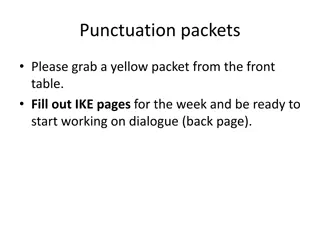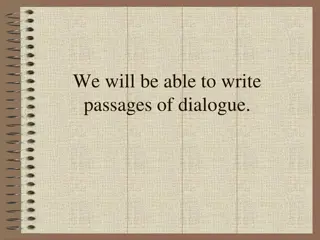Insights into Stage Dialogue and Craftsmanship in Playwriting
Stage dialogue differs from real-life conversations, with a focus on attentive and courteous listening. Stage conventions like asides and set speeches serve to convey inner thoughts and showcase actors' skills. Crafting effective dialogue in plays involves balancing information and aesthetic appeal, with the need to act out or read aloud dialogue for proper analysis. Understanding these nuances is crucial for successful playwriting and performance.
Download Presentation

Please find below an Image/Link to download the presentation.
The content on the website is provided AS IS for your information and personal use only. It may not be sold, licensed, or shared on other websites without obtaining consent from the author.If you encounter any issues during the download, it is possible that the publisher has removed the file from their server.
You are allowed to download the files provided on this website for personal or commercial use, subject to the condition that they are used lawfully. All files are the property of their respective owners.
The content on the website is provided AS IS for your information and personal use only. It may not be sold, licensed, or shared on other websites without obtaining consent from the author.
E N D
Presentation Transcript
Conversations in a play have marked differences from conversations in real life. In dialogue there are fewer interruptions; people do not bore other people; almost everyone is a more attentive and courteous listener than in real life, though the quality of the talk makes boredom less likely. Unless for some special comic or pathetic effect, people are much less concerned with such practical, immediate necessities as going out to work, cleaning boots, bathing the baby; and no conversation is generally more fairly shared than among live persons in a room in real life (117).
Another convention of stage dialogue is the 'aside', a way of showing inner thoughts as opposed to outward expression. But the 'aside' is accepted on the stage as a means of showing than what one character says to another is insincere or has a double meaning. It is used very little in the more naturalistic twentieth-century drama (118 119).
A play often contains a number of great set speeches in prose or verse. These are dictated partly in good drama by the passion and creative joy of the writer; but we should not forget that they are also there to give the great actor or actress an opportunity to show skill and fervor in handling of emotion. Actors and actresses are glade to have parts that give full scope to their virtuosity, and dramatists generally seek to provide such opportunities (121).
In studying the craftsmanship of a given play we must notice the difference between dialogue whose first function is to convey information, to carry on the plot, and dialogue whose first function is to please by its beauty, wit, oddity or other intrinsic quality. A too thorough separation of these functions denotes bad dramatic craftsmanship, for much material is wasted in one sense or another and there is often some degree of division (123).
The only possible way to analyze a stage dialogue adequately is to act it, or failing that, to read it aloud; if this is quite impossible one should at least read it aloud in imagination. Moreover, many broken speeches, hesitations, ambiguous expressions and animal noises take on an interesting significance on the stage. The person who wants to succeed in play-reading should learn to laugh and cry on the stage at will (126).























